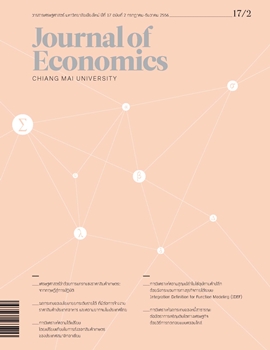การวิเคราะห์ความได้เปรียบ โดยเปรียบเทียบในการส่งออกสินค้าเกษตร ของประเทศสมาชิกอาเซียน
Keywords:
ความได้เปรียบโดยเปรียบเทียบ, ประชาคมเศรษฐกิจอาเซียน, ฮาโมไนซ์ 2-digit, comparative advantage, ASEAN Economic Community, agricultural productsAbstract
การศึกษาเรื่องการวิเคราะห์ความได้เปรียบโดยเปรียบเทียบในการส่งออกสินค้าเกษตร ของประเทศสมาชิกอาเซียนนี้มีวัตถุประสงค์เพื่อศึกษาถึงสถานการณ์การส่งออกสินค้า เกษตรของประเทศไทย ความได้เปรียบโดยเปรียบเทียบในการส่งออกสินค้าเกษตรของ ประเทศไทยและประเทศสมาชิกอาเซียน รวมถึงศักยภาพของการส่งออกสินค้าเกษตรของไทย และประเทศสมาชิกอาเซียน โดยใช้วิธีการหาค่าดัชนีความสามารถในการส่งออก รวมถึง ค่าส่วนแบ่งตลาดรวม ค่าผลกระทบทางโครงสร้าง ค่าผลกระทบทางการดำเนินงาน และ ค่าผลกระทบรวม สินค้าเกษตรที่ทำการศึกษา ได้แก่ สินค้าเกษตรสำคัญ 3 ชนิดตามรหัส ฮาโมไนซ์ คือ สินค้าเกษตรรหัส 16 ได้แก่ ของปรุงแต่งจากเนื้อสัตว์ ปลาหรือสัตว์นํ้าจำพวก ครัสตาเซีย โมลลุสก์ หรือจากสัตว์นํ้าที่ไม่มีกระดูกสันหลังอื่นๆ สินค้าเกษตรรหัส 10 ได้แก่ ธัญพืช และสินค้าเกษตรรหัส 17 ได้แก่ นํ้าตาลและขนมทำจากนํ้าตาล ข้อมูลที่ใช้ได้แก่ มูลค่า การส่งออกสินค้าเกษตรทั้ง 3 ชนิดของประเทศสมาชิกอาเซียน, มูลค่าการส่งออกสินค้าเกษตร ทั้ง 3 ชนิด จากตลาดโลกสู่ประเทศสมาชิกอาเซียน และข้อมูลการส่งออกสินค้าเกษตรทั้ง 3 ชนิดไปยังตลาดโลก ซึ่งเป็นข้อมูลทุติยภูมิรายปีตั้งแต่ พ.ศ. 2550-2554 ผลการศึกษาพบว่า ประเทศฟิลิปปินส์ ไทย และเวียดนามมีความได้เปรียบโดยเปรียบเทียบในการส่งออกสินค้า เกษตรรหัส 16 โดยที่ประเทศไทยมีการครองตลาดมากที่สุดและมีแนวโน้มครองส่วนแบ่ง ตลาดเพิ่มขึ้น ประเทศที่มีความได้เปรียบโดยเปรียบเทียบในการส่งออกสินค้าเกษตรรหัส 10 ได้แก่ ประเทศกัมพูชา ลาว ไทย และเวียดนาม โดยที่ประเทศเวียดนามมีส่วนแบ่งตลาด สูงที่สุด ส่วนประเทศไทยมีแนวโน้มการครองส่วนแบ่งตลาดค่อนข้างทรงตัว ส่วนประเทศ ที่มีความได้เปรียบโดยเปรียบเทียบในการส่งออกสินค้าเกษตรรหัส 17 ได้แก่ ประเทศกัมพูชา ลาว ฟิลิปปินส์ และไทย โดยที่ประเทศไทยมีความได้เปรียบโดยเปรียบเทียบทุกปีที่ทำการ ศึกษาและมีส่วนแบ่งตลาดที่สูงมาก
ANALYSIS OF THE COMPARATIVE ADVANTAGE IN AGRICULTURAL EXPORTS OF ASEAN MEMBERS
The objectives of this study on the analysis of the comparative advantage in agricultural exports of ASEAN member states are to examine Thailand’s agricultural export situation, and determine the comparative advantage of Thailand and other ASEAN members in agricultural exports as well as individual country’s agricultural export potential. The analysis was based on the export specialization index, including the components of market share, structural effect, operational effect, and total effect. The agricultural commodities under investigation covered three major categories of traded products in the Harmonized Coding System (HS) including HS code 16 for edible preparations of meat, fish or crustacean and mollusk species, or other invertebrates, HS code 10 for cereals, and HS code 17 for sugars and sugar confectionery. Used for the analysis were the secondary annual data during 2007—2011 period on the export values of the products in the above three classifications originating from ASEAN member states, the export values of the products in the above three classifications from the world market destining at ASEAN member states, and the quantities of exports of the products in these three categories to the world market.
The findings indicated the countries that had comparative advantage in the exports of HS code 16 products were the Philippines, Thailand, and Viet Nam with Thailand holding the largest market share which also had a tendency to grow further. Countries having comparative advantage in exporting HS code 10 products were found to be Cambodia, Laos, Thailand, and Viet Nam with Viet Nam holding the largest market share and Thailand tending to maintain a stable market share. Those countries with comparative advantage in exporting HS code 17 products appeared to be Cambodia, Laos, the Philippines, and Thailand with Thailand having the most trade advantage and the largest market share throughout the studied period.
Downloads
Issue
Section
License
All opinions and contents in the CMJE are the responsibility of the author(s). Chiang Mai University Journal of Economics reserves the copyright for all published materials. Papers may not be reproduced in any form without the written permission from Chiang Mai University Journal of Economics.
ข้อคิดเห็นที่ปรากฏและแสดงในเนื้อหาบทความต่างๆในวารสารเศรษฐศาสตร์มหาวิทยาลัยเชียงใหม่ ถือเป็นความเห็นและความรับผิดชอบโดยตรงของผู้เขียนบทความนั้นๆ มิใช่เป็นความเห็นและความรับผิดชอบใดๆของวารสารเศรษฐศาสตร์ มหาวิทยาลัยเชียงใหม่
บทความ เนื้อหา และข้อมูล ฯลฯ ในวารสารเศรษฐศาสตร์มหาวิทยาลัยเชียงใหม่ ถือเป็นลิขสิทธิ์เฉพาะของคณะเศรษฐศาสตร์มหาวิทยาลัยเชียงใหม่ หากบุคคลหรือหน่วยงานใดต้องการนำทั้งหมดหรือส่วนหนึ่งส่วนใดไปเผยแพร่ต่อหรือเพื่อกระทำการใดๆ จะต้องได้รับอนุญาตเป็นลายลักษณ์อักษร จากวารสารเศรษฐศาสตร์ มหาวิทยาลัยเชียงใหม่






